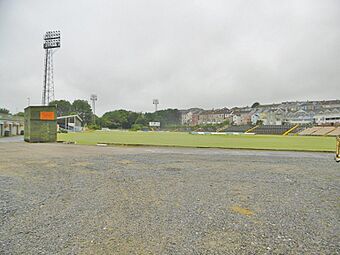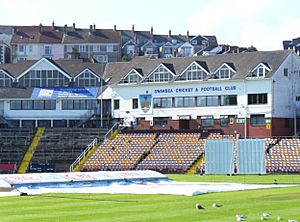St Helen's Rugby and Cricket Ground facts for kids
 |
|||||||||
| Location | Brynmill, Swansea, SA2 0AR | ||||||||
|---|---|---|---|---|---|---|---|---|---|
| Coordinates | 51°36′45″N 3°57′56″W / 51.61250°N 3.96556°W | ||||||||
| Owner | City and County of Swansea Council | ||||||||
| Operator | Swansea Council | ||||||||
| Capacity | 8,396 (expected) | ||||||||
| Surface | Grass | ||||||||
| Construction | |||||||||
| Broke ground | 1873 | ||||||||
| Opened | 1873 | ||||||||
| Renovated | 2024-2025 | ||||||||
| Tenants | |||||||||
| Swansea RFC Swansea University RFC Ospreys (rugby union) |
|||||||||
| Ground information | |||||||||
| International information | |||||||||
| First ODI | 18 July 1973: |
||||||||
| Last ODI | 9 June 1983: |
||||||||
| Only WODI | 21 July 1973: |
||||||||
| Team information | |||||||||
|
|||||||||
| As of 22 May 2025 Source: Cricinfo |
|||||||||
St Helen's Ground is a famous sports stadium in Swansea, Wales. The City and County of Swansea Council owns and runs it. It's mostly used for rugby union and cricket. For a long time, it was the home of Swansea RFC and Swansea Cricket Club. In 2025, the Ospreys rugby team moved back to St Helen's after playing at the Swansea.com Stadium for 20 years.
St Helen's Ground is special because it hosted the very first home match for the Wales national rugby team in 1882. The Welsh team played many games there, including in the Five Nations Championship, until 1954. Since then, only one full international rugby match has been played there, in 1997. More recently, the Wales women's team has used the ground.
Glamorgan County Cricket Club also played many of their matches at St Helen's from 1921 to 2019. The ground has hosted two big international cricket games called One Day Internationals. In 1973, England played New Zealand there. In 1983, a World Cup match between Pakistan and Sri Lanka took place at St Helen's.
A very famous moment in cricket history happened here. Sir Garfield Sobers hit six sixes in one over, which is the most runs possible. This was the first time anyone had done this in a first-class cricket match. In July 2024, Glamorgan announced they would not return to play at the ground.
St Helen's has also hosted international games in two other sports. The Wales rugby league team played thirteen matches there between 1945 and 1978. Two of these were part of the 1975 Rugby League World Cup. A football international match between Wales and Ireland was played at St Helen's in 1894.
In the summer of 2024, it was announced that the Ospreys rugby team would return to St Helen's for the 2025/26 rugby season. To prepare for this, the cricket facilities were replaced with new stands for rugby. This meant Swansea Cricket Club left the stadium after about 150 years.
Contents
History of St Helen's Ground
Since it opened in 1873, St Helen's Ground has been the home of the Swansea Rugby Football Club and the Swansea Cricket Club.
In 1928, a young Dylan Thomas, who later became a famous poet, won a mile race at the ground. This was during Swansea Grammar School's Sports Day. He kept a newspaper photo of his win until he passed away.
Before 2005, the stadium could hold 10,500 seated fans. The well-known east stand, which covered part of Oystermouth Road, was later taken down. A new metal stand replaced it. In late 2007, a wall near Mumbles Road was rebuilt further inside the ground. This made space for a new car park with 39 spots for the Patti Pavilion.
St Helen's Ground is said to have the tallest freestanding flood light in Europe. This light, in the north-eastern corner, stands at 150 feet (45 meters) tall.
After talks between the Ospreys rugby club and Swansea Council, it was decided in 2024 that the Ospreys would take over from Swansea Cricket Club as the main team at St Helen's. Swansea Cricket Club had been there since 1875 and looked for a new home. The stadium was renovated in 2024/25 with new stands. It became a rugby-focused field with a special 4G pitch. Swansea RFC and Swansea University RFC continue to play rugby there.
Rugby Matches at St Helen's
The first home international rugby match for Wales was played at St Helen's on December 16, 1882, against England. The ground also saw New Zealand's first win over Wales in 1924.
On April 10, 1954, St Helen's hosted its last international rugby match for many years. Another Test match between Wales and Tonga was played there in 1997. Swansea stopped being a regular international rugby venue in the 1950s. This was partly because the ground, which could hold 50,000 people, was often too crowded. Also, travel delays to the west and higher earnings from games at Cardiff Arms Park played a role. Swansea Corporation thought about making the stadium bigger, but war damage to the city meant other building projects were more important.
However, the ground has hosted three Welsh women's international matches. The first women's international at Swansea was in April 1999 against England. The most recent was in November 2009, when Wales beat Sweden 56–7.
Swansea RFC made history at St Helen's on September 28, 1935. They beat New Zealand 11–3, becoming the first club team to defeat the All Blacks. Swansea also beat the world champions Australia 21–6 in November 1992. This was Australia's first match of their Welsh Tour.
Between 1919 and 1952, St Helen's was also the home of Swansea Uplands RFC. The club later moved to Upper Killay.
During the 1975 Rugby League World Cup, Australia beat Wales 18–6. Over 11,000 fans watched this match, which was shown on the BBC. The two teams played again at Swansea in 1978, with Australia winning 8-3.
In July 2024, it was announced that the Ospreys would leave the Swansea.com Stadium after 20 years. They returned to play in the newly rebuilt St Helen's. As part of these changes, Swansea Cricket Club left the home they had used since 1875.
Rugby League International Matches
Here is a list of international rugby league matches played at St Helen's.
Football Matches at St Helen's
Here is a list of Wales International football matches played at St Helen's.
| Date | Opponent | Result | Attendance | Notes |
|---|---|---|---|---|
| 24 February 1894 | 4-1 | 7,000 | Played as part of the 1893-94 British Home Championship |
Cricket History and Records
In 1968, Garfield Sobers achieved a famous feat at this ground. He hit six sixes in one over in first-class cricket. Sobers was playing as captain for Nottinghamshire against Glamorgan.
Glamorgan County Cricket Club used St Helen's as one of their home grounds. They also played at their main ground, SWALEC Stadium in Cardiff, and Penrhyn Avenue in Rhos-on-Sea. This showed their commitment to playing across all of Wales.
The Wales Minor Counties Cricket Club also uses St Helen's as a home base. They have played minor counties cricket since 1988. They are currently the only non-English team in the Minor Counties Championship.
International Cricket Centuries
Only one century (100 runs or more) has been scored in a One Day International match at St Helen's.
| No. | Score | Player | Team | Balls | Opposing team | Date | Result |
|---|---|---|---|---|---|---|---|
| 1 | 100 | Dennis Amiss | 121 | 18 July 1973 | Won |
Images for kids



